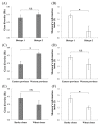Genetic Divergence of Two Sitobion avenae Biotypes on Barley and Wheat in China
- PMID: 32054103
- PMCID: PMC7073604
- DOI: 10.3390/insects11020117
Genetic Divergence of Two Sitobion avenae Biotypes on Barley and Wheat in China
Abstract
Host plant affinity and geographic distance can play critical roles in the genetic divergence of insect herbivores and evolution of insect biotypes, but their relative importance in the divergence of insect populations is still poorly understood. We used microsatellite markers to test the effects of host plant species and geographic distance on divergence of two biotypes of the English grain aphid, Sitobion avenae (Fabricius). We found that clones of S. avenae from western provinces (i.e., Xinjiang, Gansu, Qinghai and Shaanxi) had significantly higher genetic diversity than those from eastern provinces (i.e., Anhui, Henan, Hubei, Zhejiang and Jiangsu), suggesting their differentiation between both areas. Based on genetic diversity and distance estimates, biotype 1 clones of eastern provinces showed high genetic divergence from those of western provinces in many cases. Western clones of S. avenae also showed higher genetic divergence among themselves than eastern clones. The Mantel test identified a significant isolation-by-distance (IBD) effect among different geographic populations of S. avenae, providing additional evidence for a critical role of geography in the genetic structure of both S. avenae biotypes. Genetic differentiation (i.e., FST) between the two biotypes was low in all provinces except Shaanxi. Surprisingly, in our analyses of molecular variance, non-significant genetic differentiation between both biotypes or between barley and wheat clones of S. avenae was identified, showing little contribution of host-plant associated differentiation to the divergence of both biotypes in this aphid. Thus, it is highly likely that the divergence of the two S. avenae biotypes involved more geographic isolation and selection of some form than host plant affinity. Our study can provide insights into understanding of genetic structure of insect populations and the divergence of insect biotypes.
Keywords: biotype development; genetic differentiation; genetic structure; genotype; geographic populations; host-associated differentiation.
Conflict of interest statement
Supplementary Materials: The following are available online at www.mdpi.com/xxx/s1.
Figures






Similar articles
-
Clonal Diversity and Genetic Differentiation of Sitobion avenae (Hemiptera: Aphididae) From Wheat and Barley in China.J Econ Entomol. 2019 May 22;112(3):1217-1226. doi: 10.1093/jee/toy426. J Econ Entomol. 2019. PMID: 30690533
-
Identification and Genetic Differentiation of Sitobion avenae (Hemiptera: Aphididae) Biotypes in China.J Econ Entomol. 2020 Feb 8;113(1):407-417. doi: 10.1093/jee/toz244. J Econ Entomol. 2020. PMID: 31586197
-
Transcriptome profiling revealed potentially important roles of defensive gene expression in the divergence of insect biotypes: a case study with the cereal aphid Sitobion avenae.BMC Genomics. 2020 Aug 6;21(1):546. doi: 10.1186/s12864-020-06950-y. BMC Genomics. 2020. PMID: 32762647 Free PMC article.
-
Transcriptome Profiling Revealed Potentially Critical Roles for Digestion and Defense-Related Genes in Insects' Use of Resistant Host Plants: A Case Study with Sitobion Avenae.Insects. 2020 Jan 30;11(2):90. doi: 10.3390/insects11020090. Insects. 2020. PMID: 32019207 Free PMC article.
-
Wheat-Fusarium graminearum Interactions Under Sitobion avenae Influence: From Nutrients and Hormone Signals.Front Nutr. 2021 Sep 8;8:703293. doi: 10.3389/fnut.2021.703293. eCollection 2021. Front Nutr. 2021. PMID: 34568403 Free PMC article. Review.
Cited by
-
The Peculiarities of Metopolophium dirhodum (Walk.) Population Formation Depending on Its Clonal and Morphotypic Organization during the Summer Period.Insects. 2023 Mar 8;14(3):271. doi: 10.3390/insects14030271. Insects. 2023. PMID: 36975956 Free PMC article.
-
Population Genetics, Demographic History, and Potential Distributions of the New Important Pests Monolepta signata (Coleoptera: Chrysomelidae) on Corn in China.Insects. 2025 Mar 19;16(3):323. doi: 10.3390/insects16030323. Insects. 2025. PMID: 40266817 Free PMC article.
References
-
- Cobben M.M., Verboom J., Opdam P.F., Hoekstra R.F., Jochem R., Smulders M.J. Landscape prerequisites for the survival of a modelled metapopulation and its neutral genetic diversity are affected by climate change. Landsc. Ecol. 2012;27:227–237. doi: 10.1007/s10980-011-9676-1. - DOI
Grants and funding
LinkOut - more resources
Full Text Sources
Miscellaneous

